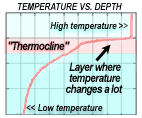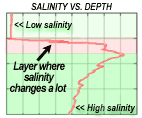 |
|
The availability of "ingredients" that phytoplankton need to grow -- carbon, nutrients, light -- is directly tied to the ocean's physical environment.
|
|
 |
Oceans can be layered with upper waters that are distinctly less dense than deeper waters. This causes a physical "barrier" to form, separating the surface from the nutrient-rich colder waters below. At left (<<<), the thermocline -- a thin layer where temperature changes abruptly -- separates shallow from deep waters. The lower plot (<<<) shows how low salinity water can "float" above high salinity water. Under mixed conditions, temperature and salinity DO NOT vary much from shallow to deep. During high mixing, phytos are suspended in a turbulent ocean, spending time in both the sunlit upper ocean and the deeper dark zone. |
|
 |
||
|
#1) Discover whether stations had layered or mixed conditions when sampled. STEP A: Look at each season's temperature profiles (background) for: Station 3 | Station 4 | Station 5 | Station 6 | Station 7 | Station 8 | Station 9 | Station 10 | Station 11 | Station 12 |
||
|
Download & print "Data Tracking Sheet" (PDF format). Keep track of the following:
STEP B: Now examine their salinity profiles (background): Station 3 | Station 4 | Station 5 | Station 6 | Station 7 | Station 8 | Station 9 | Station 10 | Station 11 | Station 12
|
|
#2) Compare the top of the thermocline with the depth of fluorescence. STEP A: For stations with layered conditions (see "Data Tracking Sheet" from Activity #1), find the depth where there is a distinct decrease in the temperature (example at right, >>): Station 3 | Station 4 | Station 5 | Station 6 | Station 7 | Station 8 | Station 9 | Station 10 | Station 11 | Station 12
|
 |
|
STEP B: Find the corresponding graph of fluorescence for these stations. Note the depth where the fluorescence (background) drops below the value of 1: Station 3 | Station 4 | Station 5 | Station 6 | Station 7 | Station 8 | Station 9 | Station 10 | Station 11 | Station 12
|
|
#3) Examine whether phytoplankton species diversity is tied to layered versus mixed ocean conditions. STEP A: Look at the plankton net samples and descriptions for every station during each season: Station 1 | Station 2 | Station 3 | Station 4 | Station 5 | Station 6 | Station 7 | Station 8 | Station 9 | Station 10 | Station 11 | Station 12
STEP B: When possible, compare these findings with whether each station is "layered" or "mixed" during that season (analyzed during Activity #1). |
|
One view of the relationship between physical conditions and phytoplankton is shown at right (>>>). According to your Gulf of Maine research, are certain types of phytoplankton thrive better under layered conditions? How about mixed conditions? Does the diversity of "successful
species" change from season to season? Why or why not?
|
 |